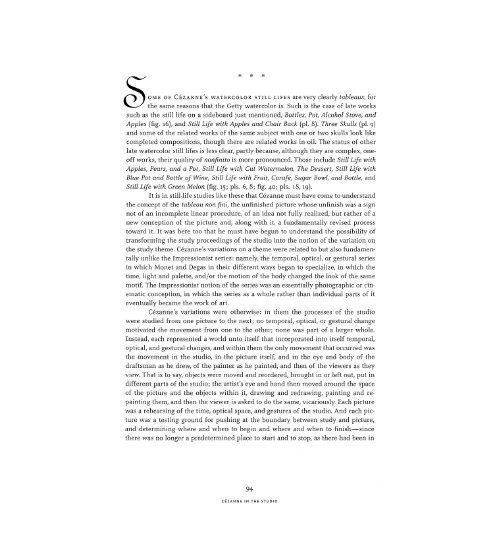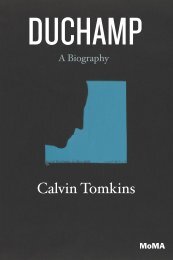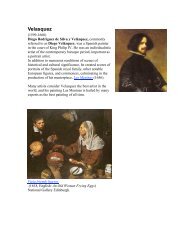Still Life in Watercolors
qbj8dgc
qbj8dgc
- No tags were found...
Create successful ePaper yourself
Turn your PDF publications into a flip-book with our unique Google optimized e-Paper software.
SOME OF CEZANNE'S WATERCOLOR STILL LIFES are very clearly tableaux, for<br />
the same reasons that the Getty watercolor is. Such is the case of late works<br />
such as the still life on a sideboard just mentioned, Bottles, Pot, Alcohol Stove, and<br />
Apples (fig. 16), and <strong>Still</strong> <strong>Life</strong> with Apples and Chair Back (pi. 8). Three Skulls (pi. 9)<br />
and some of the related works of the same subject with one or two skulls look like<br />
completed compositions, though there are related works <strong>in</strong> oil. The status of other<br />
late watercolor still lifes is less clear, partly because, although they are complex, oneoff<br />
works, their quality of nonf<strong>in</strong>ito is more pronounced. Those <strong>in</strong>clude <strong>Still</strong> <strong>Life</strong> with<br />
Apples, Pears, and a Pot, <strong>Still</strong> <strong>Life</strong> with Cut Watermelon, The Dessert, <strong>Still</strong> <strong>Life</strong> with<br />
Blue Pot and Bottle of W<strong>in</strong>e, <strong>Still</strong> <strong>Life</strong> with Fruit, Carafe, Sugar Bowl, and Bottle, and<br />
<strong>Still</strong> <strong>Life</strong> with Green Melon (fig. 15; pis. 6, 8; fig. 40; pis. 18,19).<br />
It is <strong>in</strong> still-life studies like these that Cézanne must have come to understand<br />
the concept of the tableau non f<strong>in</strong>i, the unf<strong>in</strong>ished picture whose unf<strong>in</strong>ish was a sign<br />
not of an <strong>in</strong>complete l<strong>in</strong>ear procedure, of an idea not fully realized, but rather of a<br />
new conception of the picture and, along with it, a fundamentally revised process<br />
toward it. It was here too that he must have begun to understand the possibility of<br />
transform<strong>in</strong>g the study proceed<strong>in</strong>gs of the studio <strong>in</strong>to the notion of the variation on<br />
the study theme. Cezanne's variations on a theme were related to but also fundamentally<br />
unlike the Impressionist series: namely, the temporal, optical, or gestural series<br />
<strong>in</strong> which Monet and Degas <strong>in</strong> their different ways began to specialize, <strong>in</strong> which the<br />
time, light and palette, and/or the motion of the body changed the look of the same<br />
motif. The Impressionist notion of the series was an essentially photographic or c<strong>in</strong>ematic<br />
conception, <strong>in</strong> which the series as a whole rather than <strong>in</strong>dividual parts of it<br />
eventually became the work of art.<br />
Cezanne's variations were otherwise: <strong>in</strong> them the processes of the studio<br />
were studied from one picture to the next; no temporal, optical, or gestural change<br />
motivated the movement from one to the other; none was part of a larger whole.<br />
Instead, each represented a world unto itself that <strong>in</strong>corporated <strong>in</strong>to itself temporal,<br />
optical, and gestural changes, and with<strong>in</strong> them the only movement that occurred was<br />
the movement <strong>in</strong> the studio, <strong>in</strong> the picture itself, and <strong>in</strong> the eye and body of the<br />
draftsman as he drew, of the pa<strong>in</strong>ter as he pa<strong>in</strong>ted, and then of the viewers as they<br />
view. That is to say, objects were moved and reordered, brought <strong>in</strong> or left out, put <strong>in</strong><br />
different parts of the studio; the artist's eye and hand then moved around the space<br />
of the picture and the objects with<strong>in</strong> it, draw<strong>in</strong>g and redraw<strong>in</strong>g, pa<strong>in</strong>t<strong>in</strong>g and repa<strong>in</strong>t<strong>in</strong>g<br />
them, and then the viewer is asked to do the same, vicariously. Each picture<br />
was a rehears<strong>in</strong>g of the time, optical space, and gestures of the studio. And each picture<br />
was a test<strong>in</strong>g ground for push<strong>in</strong>g at the boundary between study and picture,<br />
and determ<strong>in</strong><strong>in</strong>g where and when to beg<strong>in</strong> and where and when to f<strong>in</strong>ish—s<strong>in</strong>ce<br />
there was no longer a predeterm<strong>in</strong>ed place to start and to stop, as there had been <strong>in</strong><br />
94<br />
CÉZANNE IN THE STUDIO




